Top Bewertungen
Jetzt kostenlosen Testzugang sichern Erst probieren, dann studieren!



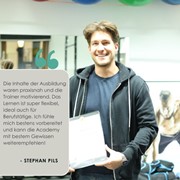
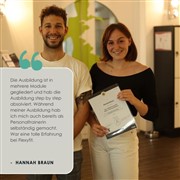
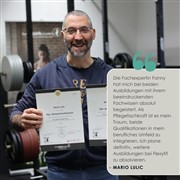
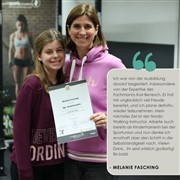
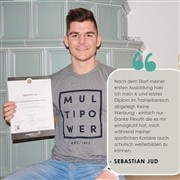

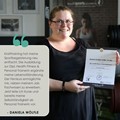
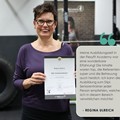
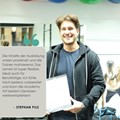
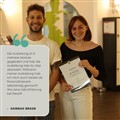
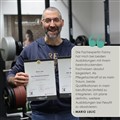

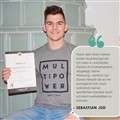

€ 5.490,- | Einzelunterricht
» UnsereLernpakete
Informationen zum Lehrgang
Anerkannt & Zertifiziert
Unsere Absolventen, Partner & Freunde sagen
Unser Team berät Sie gerne jederzeit per Telefon, Chat oder Persönlich
Jeder Triathlet weiß, dass die Vorbereitung auf einen Wettkampf nicht nur eine physische, sondern auch eine mentale Herausforderung darstellt.
Triathleten müssen diszipliniert sein und sich strikt an deren Trainingsplan halten, um ihre Ziele zu erreichen. Das gilt auch für einen Triathlontrainer beim Überwachen der Zieler seiner Kunden. Die Hauptaufgabe eines Triathlontrainers ist es, durch korrekte Trainingsplanung das effektive Training seiner Kunden zu fördern. Aber auch korrekte Technik, Leistungsdiagnostik und Motivation sind entscheidend um Fortschritte zu erzielen und bestmögliche Ergebnisse zu erzielen.
Also werden Sie zum Experten in allen Bereichen des Ausdauertrainings und lernen Sie, wie Sie Ihre Schützlinge mit viel Einfühlungsvermögen und Fachwissen effizient auf Wettkämpfe vorbereiten. Dabei wird viel Wert darauf gelegt, Ihre Fähigkeit zur differenzierten und individuellen Betreuung der verschiedensten Typen von Athleten zu fördern.
In diesem Gesamtpaket sind die 2 Einzellehrgänge Dipl. Lauftrainer und Dipl. Schwimmtrainer bereits inkludiert.
Lernumfang
1228 E
EQF-Level
Die Ausbildung orientiert sich an EQF-Level 5 »
Kursstart
Sofort möglich
Lernvariante
Einzelunterricht


Unsere Ausbildung zum Triathlontrainer vermittelt Ihnen alles, was Sie für den Start Ihrer Karriere im Sport - & Gesundheitsbereich brauchen. Egal, ob Sie als professioneller Triathlon-Coach arbeiten wollen, oder ob Sie einfach nur Ihr eigenes Training optimieren möchten: Mit der Trainer A-Lizenz legen Sie den ersten Grundstein in die richtige Richtung!
In der Präsenzphase der Ausbildung lernen Sie nicht nur aus dem Modul Triathlontrainer, sondern auch die gesammelten Inhalte der Ausbildungen Dipl. Lauftrainer und Dipl. Schwimmtrainer.
Profitieren Sie in den Präsenzkurseinheiten vom umfassenden Fachwissen unserer akademischen Referenten zu den Themen Laufsport, Wassersport und Triathlon.
Im Modul Schwimmtrainer werden verschiedene Schwimmstile wie Kraul, Rücken, Brust und Schmetterling ausführlich behandelt. Sie lernen die richtige Körperposition, Arm- und Beinbewegungen sowie Atemtechniken für jeden Stil.
Im Modul Triathlontrianer werden verschiedene Aspekte des Radfahrens behandelt, darunter Kurvenfahren, Steigungen, Abfahrten und das Fahren in der Gruppe. Sie lernen auch, wie Sie Ihre Position auf dem Fahrrad optimieren können, um aerodynamischer zu sein.
Der Lauftrainer behandelt unter anderem verschiedene Lauftechniken, darunter Laufstil, Schrittlänge, Fußaufsatz und Armhaltung. Sie lernen, wie Sie effizienter laufen und Verletzungen vorbeugen können.
Wir bringen Ihnen bei, spezielle Trainingspläne gestalten, Leistungsdiagnostiken durchzuführen und geben Ihnen einen Einblick in Materialkunde und Regelkunde für Triathlons.
Unsere Zertifikate sind weltweit gültig und werden in verschiedenen Varianten ausgestellt. Sie erhalten unser Zertifikat auf Wunsch in mehren Sprachen (DE, EN, ES), mit länderspezifischen Informationen sowie mit und ohne Notendruck.
Alle diese Varianten stehen Ihnen ein Leben lang kostenlos zum Download auf Ihrem Online-Campus zur Verfügung. Darüber hinaus erhalten Sie, je nach dem von Ihnen erworbenen Lernpaket, ein Zertifikat Ihrer Wahl, das auf hochwertigem Sonderpapier mit Prägedruck ausgestellt wird.
Es wird folgende Urkunde (in mehren Sprachen DE, EN, ES) verliehen:
Wir freuen uns, Ihnen per Kontakt telefonisch, via E-Mail oder im Chat weiterhelfen zu können. Vielleicht finden Sie die Antwort auf Ihre Frage aber in unseren allgemeinen FAQ oder Triathlontrainer FAQ.
Lernumfang
200
Sportkompetenz
912
Präsenz | Selbstsstudium
18
Literaturrecherche
90
Praktische Umsetzung
8
Zusatzaufgaben & Prüfungen
Unsere Ausbildungen sind grundsätzlich förderfähig. Ob Ihnen eine Förderung genehmigt wird, entscheidet die jeweils zuständige Förderstelle.
Wir unterstützen Sie gerne bei der Zusammenstellung aller notwendigen Kursinformationen, die Sie für Ihren Förderantrag benötigen.
Selbstverständlich stehen wir Ihnen während des gesamten Prozesses beratend zur Seite und begleiten Sie von der ersten Anfrage bis zur Einreichung Ihres Antrags. Kontaktieren Sie uns - wir kümmern uns darum, dass Sie bestmöglich vorbereitet sind!
Alle Kapitel der Fächer anzeigen

Wir bilden die besten Trainerinnen und Trainer in der Fitnessbranche aus. Von Anfang bis zum Ende und darüber hinaus begleiten und betreuen wir unsere Absolventen/Innen.
Funktionelle Anatomie ist die Grundlage für jeden Trainer/jede Trainerin im Sport und Gesundheitsbereich. Mit diesem Fachkurs erhalten Sie einen umfassenden Einblick in die Anatomie des menschlichen Körpers und erwerben damit ein profundes Wissen.
Der Kurs wird so lebendig und verständlich wie möglich gestaltet, mit Hilfe verschiedener Lehr- und Lerntechniken - angepasst auf die Bedürfnisse von Fitness & PersonaltrainerIn.
Ziel ist es, die Zusammenhänge von Bewegungsabläufen zu erkennen und die wichtigsten lateinischen Fachausdrücke zu verstehen.

In der allgemeinen Sporternährung werden unsere Teilnehmer an die Grundzüge der Ernährung herangeführt.
Als Basis wird die Zusammensetzung unserer Ernährung mit Makro- und Mikronährstoffen, sowie der Wasserhaushalt besprochen. Um verschiedene Zusammenhänge zu verstehen, wird detailliert auf den Energiehaushalt eingegangen.
Des Weiteren wird die Wirkung der einzelnen Nahrungsbestandteile auf den menschlichen Körper, sowie deren Bedeutung im sportlichen Bereich besprochen.

Da im Sport Verletzungen an der Tagesordnung stehen, ist es wichtig, über die Ursachen und Folgen der häufigsten Verletzungen Bescheid zu wissen. Im Fall der Fälle muss der/die Personaltrainerin schnell und richtig reagieren können!
Außerdem hilft das Verständnis diverser Verletzungsbilder, diese bereits präventiv vermeiden zu können.

In vielen Unternehmen ist die betriebliche Gesundheitsförderung inzwischen eine beliebte Methode, um die Gesundheit der Mitarbeiterinnen und Mitarbeiter zu stärken, Krankheiten vorzubeugen und so das Wohlbefinden der Mitarbeiter zu stärken.
Warum betriebliche Gesundheitsförderung so wichtig ist, wird in einer Einführung in die betriebliche Gesundheitsförderung aufgezeigt, Herausforderungen der betrieblichen Gesundheitsförderung dargestellt und verbreitete Organisationskrankheiten besprochen.
Außerdem lernen die KursteilnehmerInnen, welche Erfolgsfaktoren der betrieblichen Gesundheitsförderung es gibt, welchen Nutzen die Beschäftigten und das Unternehmen daraus ziehen und natürlich bewährte Vorgehensweisen und Instrumente.
Dazu werden verschiedene Betätigungsfelder und Maßnahmen dazu vorgestellt und den Kursteilnehmern auch erklärt, wie man in solche Firmen kommt, Konzepte erstellt und andere wichtige organisatorische Dinge abklärt.
Die KursteilnehmerInnen bekommen Praktische Beispiele gezeigt und bekommen in dieser Einheit auch die Möglichkeit, das Gelernte in einer Gruppenarbeit anzuwenden.

Bei der Einheit Kundenorientiertes Arbeiten geht es darum, den KursteilnehmerInnen Einblicke in das Marketing zu geben, damit sie sich als Trainer/In später gut am Markt platzieren können und ihnen der Einstieg in den Markt erleichtert wird.
Dazu wird zuerst definiert, was Marketing überhaupt ist und weshalb es auch als PersonaltrainerIn seine Relevanz hat.
Außerdem werden gängige Fachbegriffe aus dem Marketing wie USP, Nutzen, Positionierung etc. und verschiedene Modelle des Marketings wie die SMART-Formel, der Marketingmix 4P und andere erklärt.
Auf die Kommunikation zwischen Trainer/In und Kunden/Innen wird in dieser Einheit natürlich nicht vergessen. Dazu werden verschiedene Aspekte der Kommunikation sowie Regeln für erfolgreiche Kommunikation eingeführt und Beispiele gezeigt.
Am Ende dieser Einheit sollten die KursteilnehmerInnen in der Lage sein, sich und ihr Produkt, die Dienstleistung, anhand einer Marketingstrategie am Markt zu positionieren und erfolgreich zu verkaufen.

Gute Kenntnisse der Physiologie des Menschen und die damit verbundenen Funktionen im Köper sind für alle im Sportbereich tätigen TrainerInnen eine notwendige Voraussetzung zur adäquaten Ausübung ihres Berufes.
Mit diesem Kurs werden Ihnen die Zusammenhänge des menschlichen Organismus "begreifbar" gemacht. Reisen Sie mit uns durch den menschlichen Körper und verstehen Sie die Funktionen des Organismus für Ihr neues Berufsbild im Sport.
Im Unterrichtsfach wird möglichst praxisnah und spannend die Energiebereitstellung des Muskels, das Herzkreislaufsystem und das Atmungssystem erkundet.
Eine gute Sport-Ausbildung beginnt an der Basis mit Anatomie und Physiologie.

In diesem Kurs werden die TeilnehmerInnen darauf vorbereitet, auf allen Ebenen mit dem Kunden/der Kundin erfolgreich kommunizieren zu können. Außerdem sollen dich die TeilnehmerInnen mit ihren eigenen Zielen und Motiven auseinanderzusetzen, um die der KundInnen besser verstehen zu können.
Das richtige Zielsetzung sowie korrektes Erteilen von Feedback sind ebenfalls Teile der Lehrveranstaltung!
Auch die Stressbewältigung und verschiedene Lernstrategien werden den Teilnehmenden näher gebracht, um diese nach der Ausbildung anwenden zu können.

Im ersten Teil der Trainingslehre werden die Grundlagen des Trainings, wie Trainingsprinzipien, Prinzipien der Trainingsgestaltung, Trainingsmethoden und die Faktoren der sportlichen Leistung vermittelt.
Da die Leistungsfähigkeit, Leistungsdiagnostik, Training und Wettkampf, in enger Wechselwirkung zueinander stehen, werden sie auch dementsprechend im Kurs unterrichtet.
Im zweiten Teil der Trainingslehre wird das Training als komplexer Handlungsprozess und im Zusammenhang mit Planung, Ausführung und Evaluation definiert und bewertet.
Ein wichtiger Teil der Trainingslehre ist nach wie vor die Trainingsplangestaltung, die mit Beispielen über die Möglichkeiten einer Trainingsplangestaltung praktisch vermittelt werden.
Um noch tiefer in die Trainingswissenschaft einzutauchen, haben wir mit internationalen Top-Referenten wie Prof. em. Dr. phil. Dr. med. Dr. h.c. Jürgen Weineck zusätzlich einen Video-Workshop zum Thema Höhentraining entwickelt.
Alle Kapitel der Fächer anzeigen

ABSCHLUSS & ZIEL
FALLBEISPIELE & ATHLETENANALYSE
INDIVIDUELLE TRAININGSSTRATEGIE
FALLANALYSE & TRAININGSENTWICKLUNG
TRAININGSPLANUNG DURCH TEILNEHMER
PRÄSENTATION & FEEDBACK


GRUNDLAGEN DER SPORTERNÄHRUNG IM TRIATHLON
ERNÄHRUNGSSTRATEGIEN IM TRAINING
FLÜSSIGKEITS- & ELEKTROLYTMANAGEMENT
WETTKAMPFERNÄHRUNG FÜR VERSCHIEDENE DISTANZEN
REGENERATION & ERNÄHRUNG IM WETTKAMPF
SUPPLEMENTS & COACHINGPRAXIS



GRUNDLAGEN DER REGENERATION IM TRIATHLON
REGENERATIONSMAßNAHMEN IN DER PRAXIS
SCHLAF ALS LEISTUNGSFAKTOR
MONITORING & COACHING DER REGENERATION

In diesem Fach lernst du die technische Basis des Triathlons kennen. Du erfährst, wie saubere Bewegungsabläufe, effiziente Fahrtechnik und das richtige Material deine Leistung entscheidend beeinflussen.
Im Radtraining arbeitest du an Stabilität, Kurventechnik, Schaltverhalten und einer ökonomischen Tretbewegung. Im Wechseltraining übst du klare, schnelle Abläufe für T1 und T2, damit du Zeit sparst und routiniert durch den Wettkampf kommst. Im Koppeltraining lernst du, den Übergang zwischen den Disziplinen optimal zu gestalten und die typische Umstellungsphase gezielt zu trainieren.
Das Fach verbindet alle Disziplinen zu einem praxisnahen Gesamtbild, damit du im Triathlon sicherer, effizienter und leistungsfähiger unterwegs bist.
EINFÜHRUNG IN TECHNIKTRAINING & MATERIALKUNDE
RADTECHNIK I - GRUNDLAGEN & FAHRTECHNIK
RADTECHNIK II - EFFIZIENZ & TECHNIKTRAINING
WECHSELTRAINING I - GRUNDLAGEN
WECHSELTRAINING II - PRAXISSIMULATION
KOPPELTRAINING I - THEORIE & GRUNDLAGEN
KOPPELTRAINING II - PRAXIS & UMSETZUNG
TECHNIKTRAINING GANZHEITLICH - ZUSAMMENFÜHRUNG & ANALYSE

Alle Kapitel der Fächer anzeigen

Die Grundlagen des Laufens behandeln zentrale Themen rund um das Lauftraining und die Rolle des Lauftrainers. Dabei wird die Vielseitigkeit und Bedeutung des Laufens als Sportart hervorgehoben, da es eine zugängliche, flexible Sportart ist, die sowohl körperliche als auch mentale Vorteile bietet, wie die Stärkung des Herz-Kreislauf-Systems, die Verbesserung der Ausdauer und die Reduktion von Stress. Ein Schwerpunkt liegt auf den physiologischen Grundlagen des Laufens, insbesondere dem Energiestoffwechsel (aerob und anaerob), der Funktion des Herz-Kreislauf-Systems und der Muskulatur sowie der wichtigen Rolle der Regeneration, um Überlastungsschäden zu vermeiden und den Körper an steigende Belastungen anzupassen.
Verschiedene Typen von Läufern, wie Freizeitläufer, ambitionierte Läufer und Gruppenläufer, die jeweils unterschiedliche Ziele und Motivationen verfolgen, werden vorgestellt. Es wird betont, wie wichtig es für einen Trainer ist, diese individuellen Bedürfnisse zu verstehen und darauf einzugehen. Motivation und Zielsetzung spielen dabei eine zentrale Rolle, sei es durch persönliche, wettkampforientierte oder soziale Antriebe. Schlüsselkonzepte im Lauftraining, wie die Optimierung des Laufstils, die langfristige Trainingsplanung und Maßnahmen zur Regeneration und Verletzungsprävention sind ebenso zentrale Themen. Diese Inhalte bieten eine umfassende Grundlage für die professionelle und individuelle Betreuung von Läufern.


Das Coaching von Laufgruppen befasst sich mit der effektiven Betreuung und Motivation von Laufgruppen. Es hebt die Vorteile von Laufgruppen hervor, darunter die gegenseitige Motivation, soziale Vernetzung, gesundheitliche Vorteile und die Möglichkeit, durch gemeinsames Training Wettkämpfe vorzubereiten. Laufgruppen bieten zudem mentale Unterstützung, Abwechslung und helfen, Selbstvertrauen zu stärken.
Ein weiterer zentraler Punkt sind die Herausforderungen, die in Laufgruppen auftreten können, wie unterschiedliche Leistungsniveaus, Motivationsprobleme und Konflikte innerhalb der Gruppe. Strategien zur Bewältigung dieser Herausforderungen werden vorgestellt, beispielsweise durch die Einteilung in leistungsgerechte Gruppen, klare Kommunikation, abwechslungsreiche Trainingseinheiten und das Fördern von Gruppendynamik.
Die Prinzipien der Trainingsgestaltung wie die Flexibilität, Integration und Individualisierung werden vorgestellt und zeigen, wie sie in der Praxis umgesetzt werden können. Beispiele wie Intervalltraining, Pyramidenläufe und Technikübungen bieten Anleitungen für ein vielfältiges Training, das Anfänger und Fortgeschrittene gleichermaßen einbezieht. Abschließend werden verschiedene Methoden vorgestellt, um das Training abwechslungsreich und motivierend zu gestalten, darunter Tempogruppen, Staffelläufe und Fahrtspiele, um die Gruppendynamik zu fördern und unterschiedliche Bedürfnisse zu berücksichtigen.

Die Lauftechnik ist neben den metabolischen ( inneren ) Parametern mitunter DIE wichtigste Determinante der Ausdauerleistungsfähigkeit.
Der Begriff Bewegungsökonomie bezieht sich vereinfacht gesprochen auf den Grad an energetischer Effizienz der Lauf Bewegungen. Oder anders ausgedrückt, wie viel Energie verbraucht man bei jedem Laufschritt? Aus Beobachtungen und Studien der letzten Jahre können wir schlussfolgern, dass ein Großteil der Läufer, die an einer Lauftechnik- oder Bewegungsoptimierung arbeiten, eine deutliche Leistungssteigerung erzielen können.
Die Verbesserung der Lauftechnik ist vor allem für Läufer relevant, die auf einem hohen Niveau laufen und ambitionierte Ziele verfolgen. Denn wenn der Laufschritt zu groß ist und der Fuß weit vor dem Körperschwerpunkt aufsetzt, wird Energie vergeudet. Denn der Schwung der Laufbewegung wird bei jedem Schritt gebremst und es wirken hohe Kräfte auf Muskulatur, Sehnen, Gelenke und Knochen ein, zudem erhöht sich auch das Verletzungsrisiko. Vor allem bei Läufern, die über die Ferse abrollen, besteht die Gefahr, den Fuß zu weit vorn aufzusetzen. Geringer ist sie bei solchen, die mit dem Mittelfuß landen und den Fuß damit automatisch näher unterhalb des Körperschwerpunkts aufsetzen.
Mit aufrechter Körperhaltung laufen:
Am Ende der Flugphase, kurz bevor der Fuß den Boden berührt, sendet das Gehirn ein Signal an die Muskulatur, um diese auf den Aufprall vorzubereiten. Die Muskeln kontrahieren, um die Gelenke zu stabilisieren. Ist diese Kommunikation aber fehlerhaft oder zu langsam kommt die Information nicht rechtzeitig bei der Muskulatur an. Auch wenn der Oberkörper nicht korrekt aufgerichtet ist, ist keine ideale Landung möglich. Wenn Sie ein Hohlkreuz machen, verschiebt sich der Oberkörper nach hinten und Sie setzen den Fuß zu weit vorn auf. Ist der Oberkörper zu weit nach vorn gebeugt, ist ebenfalls keine saubere Landung möglich..
In diesem Fach von der Lauftrainer Ausbildung wird folgender Inhalt vermittelt:


Die Gestaltung des langfristigen Leistungsaufbau (Trainingsplanung) stellt eine DER zentralen Tätigkeiten des Lauftrainers dar. In Abhängigkeit vom individuellen Ziel des jeweiligen Athleten muss eine Vielzahl an Faktoren beachtet werden um die Planung aus physiologischer wie aus psychologischer Sicht optimal zu gestalten. Je nach Leistungsniveau, (anderer) beruflicher Tätigkeit, (genetischen) Grundlagen, individueller Motivation, zeitlichen Rahmenbedingungen und äußeren Umständen variieren die Herausforderungen für die Gestaltung eines effektiven Trainingsplans enorm.
Jeder der schon einmal einen Trainingsplan für einen Wettkampf oder ein anderes sportliches Ziel erstellt hat, weiß wie komplex die Thematik ist. Viele Läufer sind sich nicht bewusst, welchen Stellenwert die richtige Trainingsplanung für den Erfolg im Wettkampf hat. Dabei ist es egal ob du einen Halbmarathon, einen Marathon oder sogar einen Ultramarathon laufen möchtest. Auch bei diesen extremen Distanzen können mithilfe der richtigen Trainingsplanung entscheidende Sekunden, ja sogar Minuten, herausgelaufen werden.
Dabei müssen viele verschiedene Faktoren berücksichtigt werden, um die Planung sowohl aus physiologischer als auch aus psychologischer Sicht optimal zu gestalten.
In diesem Fach werden sich unsere angehenden Lauftrainer genauer mit der Trainingsplanung beschäftigen und dabei insbesondere auf die folgenden Punkte eingehen:
- Welche Faktoren müssen bei der Trainingsplanung berücksichtigt werden?
- Wie wird der Leistungsaufbau optimiert?
- Wie wird die Motivation des Athleten gesteigert?
Sie müssen sich nicht nur auf die Laufstrecke und den Laufstil ihrer zukünftigen Kunden konzentrieren, sondern auch auf andere Faktoren. Die Punkte, die bei der optimalen Gestaltung eines Trainingsplanes berücksichtigt werden müssen, sind die Zielsetzung des Athleten, sein aktueller Leistungsstand, die vorhandenen Trainingsmittel und -Infrastruktur, sowie die zeitlichen und örtlichen Gegebenheiten. Bei der Zielsetzung ist es wichtig, realistische und erreichbare Ziele zu setzen, die den Athleten motivieren und ihm helfen, sich weiterzuentwickeln.
Jeder Läufer ist anders. Nicht nur was sein Ausgangsniveau, sondern auch seine Zielsetzungen und sein Training angeht. Um den jeweiligen Ansprüchen gerecht zu werden, ist es wichtig, dass der Lauftrainer die Bedürfnisse seines Athleten kennt. Nur so kann er einen Trainingsplan erstellen, der wirklich Motivation steigert und zu den gewünschten Zielen führt.


Die Vorbereitung auf einen Wettkampf umfasst gezielte Maßnahmen zur Optimierung der Leistung und Minimierung von Stress. Die Tapering-Phase spielt eine entscheidende Rolle, indem das Trainingsvolumen vor dem Wettkampf reduziert wird, um Regeneration und Superkompensation zu fördern. Durch angepasste Intensitäten und spezifische Trainingspläne wird die Leistungsfähigkeit gesteigert. Gleichzeitig ermöglicht diese Phase mentale Vorbereitung durch Visualisierung und Entspannungsübungen.
Ernährung und Hydration sind zentrale Bausteine in der Wettkampfwoche. Ein gezieltes Carbo-Loading füllt die Glykogenspeicher auf, während eine ausgewogene Flüssigkeitszufuhr Dehydration vorbeugt. Am Wettkampftag sind leicht verdauliche, kohlenhydratreiche Mahlzeiten entscheidend, ergänzt durch erprobte Gels oder Getränke während des Rennens.
Eine strukturierte Planung minimiert Stress. Eine Packliste stellt sicher, dass alle wichtigen Utensilien, von Schuhen bis hin zu Snacks, vorbereitet sind. Mentale Techniken wie Visualisierungen stärken das Selbstvertrauen, indem sie den Ablauf des Wettkampfs und mögliche Herausforderungen gedanklich durchspielen lassen. Pacemaking hilft, das Tempo optimal zu kontrollieren, Energie effizient einzuteilen und die mentale Belastung zu reduzieren.
Nach dem Wettkampf stehen Regeneration und Reflexion im Mittelpunkt. Lockere Bewegungen, gezielte Ernährung und ausreichend Schlaf fördern die körperliche Erholung. Ein Feedback-Gespräch und das Feiern der Erfolge dienen dazu, Motivation für zukünftige Wettkämpfe aufzubauen und Fortschritte zu analysieren.
Alle Kapitel der Fächer anzeigen

Die Vermittlung von Schwimmtechniken und die didaktische Gestaltung des Unterrichts gehören zu den Kernaufgaben eines Schwimmtrainers. Entscheidend ist dabei, auf das Alter, das Leistungsniveau, die Motivation und mögliche Ängste der Teilnehmer einzugehen sowie den Unterricht im Schwimmbad gut zu organisieren.
Grundlage ist der methodische Aufbau: vom Einfachen zum Komplexen. Zuerst stehen Schweben, Gleiten und Atmung im Fokus, danach Arm- und Beintechnik sowie Koordination. Unterschiede zwischen Kinder- und Erwachsenentraining, die Wahl zwischen Gruppen- oder Einzeltraining und eine klare Struktur im Becken sind zentrale Elemente.
Die Teilnehmer lernen, Schwimmeinheiten fachlich sinnvoll und zielgruppenorientiert zu gestalten. Eine praxisnahe Trainer-Checkliste gibt am Ende Struktur und Sicherheit für die eigene Unterrichtspraxis - ein unverzichtbares Werkzeug für alle, die Schwimmen erfolgreich vermitteln möchten.
TECHNIKTRAINING ERWACHSENE
KINDER-WASSERGEWÖHNUNG
DIDAKTISCHE PRINZIPIEN
GRUPPEN- VS. EINZELARBEIT
ORGANISATION IM BECKEN

Ein erfolgreicher Schwimmkurs lebt nicht nur von der Technikvermittlung, sondern vor allem von einer klaren Organisation und einer durchdachten Struktur. Damit Trainingseinheiten effektiv, abwechslungsreich und motivierend sind, braucht es ein fundiertes Wissen über Aufbau, Kursgestaltung und Feedbackmethoden.
In diesem Modul lernen angehende Schwimmtrainer, wie man Schwimmeinheiten sinnvoll plant, Kurse für unterschiedliche Zielgruppen strukturiert und dabei die Teilnehmer mit Motivation und klarer Ansprache abholt. Ob Erwachsene, Fortgeschrittene oder Triathleten - jede Gruppe stellt eigene Anforderungen, die es zu berücksichtigen gilt.
Durch praktische Beispiele, Diskussionen und die gemeinsame Analyse von Kursplänen erwerben die Teilnehmer nicht nur theoretisches Wissen, sondern auch wertvolle Werkzeuge für die Umsetzung im eigenen Unterricht.
Zum Abschluss erhalten sie eine kompakte Checkliste für die Organisation & Praxis, die als Leitfaden für ihre zukünftigen Schwimmkurse dient.
AUFBAU EINER SCHWIMMEINHEIT
STRUKTUR VON SCHWIMMKURSEN - ERWACHSENE & TRIATHLONGRUPPEN
MOTIVATION & FEEDBACK
PRAXISBEISPIELE - TRAININGSPLÄNE
HINWEISE FÜR DIE PRÄSENTATION

In diesem Kurs lernst du, welche vielseitige Rolle du im Schwimmunterricht einnimmst: Du bist nicht nur Trainer, sondern auch Motivator, Sicherheitsexperte und Begleiter deiner Teilnehmer.
Besonderes Augenmerk liegt auf deinen Aufgaben im Training - von der Planung und Durchführung über die Korrektur von Bewegungen bis hin zur individuellen Betreuung von Kindern und Erwachsenen. Du erfährst, wie du beide Zielgruppen mit der richtigen Ansprache erreichst und welche Unterschiede zwischen der Rolle eines Schwimmtrainers und eines Schwimmlehrers bestehen.
Ein zentraler Teil ist außerdem deine Verantwortung in Bezug auf Sicherheit und Aufsichtspflicht. Du lernst, wie du auch in heterogenen Gruppen den Überblick behältst, Unfälle vermeidest und klare Regeln für ein sicheres Lernumfeld schaffst. Praxisnahe Fallbeispiele zeigen dir, wie du auf typische Situationen reagieren kannst - vom Kind mit Wasserangst bis zum Erwachsenen mit Unsicherheit im tiefen Becken.
Darüber hinaus geht es um Kommunikation im Schwimmbad: klare Anweisungen trotz Lärm und Distanz, gezielter Einsatz von Körpersprache, Gestik und visuellen Hilfen. Du erfährst, wie du Kinder spielerisch motivierst und Erwachsene sachlich und lösungsorientiert begleitest.
ROLLE & AUFGABE DES SCHWIMMTRAINERS
VERANTWORTUNG, SICHERHEIT & AUFSICHTSPFLICHT
KOMMUNIKATION & COACHING IM SCHWIMMTRAINING
PRRÄSENTATIONS- & METHODIKHINWEISE

Damit Bewegungen im Wasser kraftvoll, effizient und verletzungsfrei ausgeführt werden können, ist ein gezieltes Landtraining unverzichtbar. In diesem Kurs erfahren angehende Schwimmtrainer, wie sie durch spezifisches Kraft- und Athletiktraining die Leistungsfähigkeit ihrer Schwimmer steigern und gleichzeitig eine stabile Basis für Technik und Ausdauer schaffen.
Im Mittelpunkt steht der praxisnahe Bezug zum Schwimmsport. Kraftübungen für Schultergürtel, Rücken, Core und Beine bilden die Grundlage, um Armzug, Beinschlag und Wasserlage nachhaltig zu verbessern. Ergänzt wird das Training durch Stabilisationsübungen, die eine stabile Körpermitte fördern und so Kraftübertragung und Wasserlage optimieren. Ein weiterer Schwerpunkt liegt auf der Mobility-Arbeit für Schultern und Hüfte, die nicht nur die Beweglichkeit erhöht, sondern auch Verletzungen vorbeugt und technische Abläufe erleichtert.
Die Teilnehmer lernen, wie sie Kraft, Stabilität und Mobilität in einem durchdachten Athletikzirkel kombinieren und Landtrainingseinheiten methodisch sinnvoll aufbauen. Ob für Einzelne oder ganze Gruppen - durch abwechslungsreiche Übungsformen und flexible Trainingspläne wird das Landtraining zu einem effektiven und motivierenden Bestandteil der Schwimmausbildung.
EINFÜHRUNG & KRAFTÜBUNGEN FÜR SCHWIMMER
STABILISATION & RUMPFKRAFT
MOBILITY FÜR SCHULTERN & HÜFTE
ATHLETIKZIRKEL & TRAININGSPLANUNG
HINWEISE FÜR DIE PRÄSENTATION

Das Brustschwimmen gilt als die komplexeste aller Schwimmtechniken. Armzug, Beinschlag, Atmung und die Gleitphase müssen exakt aufeinander abgestimmt sein, um eine effiziente und saubere Bewegung im Wasser zu ermöglichen. In diesem Kurs erlernen angehende Schwimmtrainer den methodischen Aufbau der Technikvermittlung und erhalten praxisnahe Werkzeuge, um Brustschwimmen erfolgreich zu unterrichten.
Zu Beginn steht die Arbeit an den Grundlagen: Wasserlage, Körperspannung und die richtige Bewegungsabfolge nach dem Prinzip "Zug - Atmen - Kick - Gleiten". Darauf aufbauend werden Arm- und Beinbewegung sowie die Atmung Schritt für Schritt eingeführt und methodisch verknüpft. Ein zentraler Bestandteil ist zudem die Fehlererkennung. Typische Probleme wie "Scherenbeine", ein zu hektischer Atemzug oder fehlerhafte Armbewegungen werden thematisiert und durch gezielte Korrekturübungen und den Einsatz von Hilfsmitteln behoben.
Im weiteren Verlauf geht es darum, die Technik ökonomischer zu gestalten. Die Teilnehmer lernen, wie sie Schwimmern eine effiziente Wasserlage vermitteln, unnötige Bewegungen reduzieren und die Gleitphase nutzen können, um mit weniger Kraftaufwand mehr Strecke zurückzulegen. Gerade für Triathleten und Fitnessschwimmer ist dieser ökonomische Ansatz entscheidend, um Energie zu sparen und die Leistung langfristig zu steigern.
GRUNDLAGEN & WASSERLAGE
ARMZUG, BEINSCHLAG & ATMUNG
FEHLERERKENNUNG & KORREKTUR
EFFIZIENZSTEIGERUNG IM BRUSTSCHWIMMEN
PRÄSENTATION & HINWEISE

Der Delfinschwimmstil gilt als die wohl anspruchsvollste und gleichzeitig eleganteste Disziplin im Schwimmen. Er fordert nicht nur Kraft, sondern vor allem Koordination, Rhythmusgefühl und eine stabile Körperspannung. In diesem Kurs lernen angehende Schwimmtrainer, wie sie die komplexe Ganzkörperbewegung methodisch aufbauen und ihren Schwimmern Schritt für Schritt vermitteln können.
Im Mittelpunkt steht die Wellenbewegung, die aus der Hüfte initiiert wird und sich über den gesamten Körper fortsetzt. Aufbauend auf dieser Grundbewegung werden Armzug, Beinschlag und Atmung nach und nach in die Technik integriert. Neben den Grundlagen im Wasser umfasst der Kurs auch spezielle Übungen an Land, die das Bewegungsverständnis fördern und den Einstieg erleichtern.
Ein weiterer Fokus liegt auf der Unterwasserphase, die besonders nach Starts und Wenden eine zentrale Rolle spielt. Hier lernen die Teilnehmer, wie sich der Delfinkick effizient einsetzen lässt, um Geschwindigkeit und Dynamik mitzunehmen. Im Anschluss folgt die Kombination aller Bewegungsabläufe zur Gesamtlage, wobei der Schwerpunkt auf Technikqualität und flüssiger Koordination liegt - nicht auf Geschwindigkeit.
Am Ende verfügen die Teilnehmer über ein strukturiertes Konzept, um den Delfinstil praxisnah und methodisch sicher zu vermitteln. Mit vielfältigen Drills, Partnerübungen und kreativen Ansätzen können sie Schwimmern jeder Leistungsstufe diesen besonderen Schwimmstil näherbringen und ihn als effektives Technik- und Koordinationstraining in ihr Repertoire integrieren.
ÜBERBLICK & TECHNIKGRUNDLAGEN DELFIN
WASSERWELLE & GANZKÖRPERKOORDINATION
TRANSITION & UNTERWASSERPHASE
KOMBINATION & GESAMTLAGE
ZUSAMMENFASSUNG & FEEDBACK

Im Mittelpunkt stehen die Grundlagen der Wasserlage, die Bedeutung von Körperspannung sowie das Zusammenspiel von Armzug, Beinschlag und Atmung. Praxisorientierte Drills helfen dabei, Bewegungsabläufe verständlich zu machen und die Koordination zwischen den einzelnen Technikbausteinen zu fördern. Zusätzlich wird vermittelt, wie Trainer Fehler schnell erkennen und durch visuelle, verbale oder taktile Hilfen korrigieren können.
Ein weiterer Schwerpunkt ist das Schwimmen im Freiwasser, das im Triathlon und in offenen Gewässern eine besondere Rolle spielt. Hier lernen die Teilnehmer, wie sie Orientierung, Sicherheit und taktische Aspekte wie Bojenmanöver oder Starts in der Gruppe in ihre Trainingsgestaltung integrieren.
GRUNDLAGE & WASSERLAGE KRAUL
BEINSCHLAG (FLUTTER KICK)
ARMZUG (PULL & CATCH)
ATMUNG & RHYTHMUS
INTEGRATION - GESAMTBEWEGUNG KRAUL
FREIWASSERSCHWIMMEN I - ORIENTIERUNG & SICHERHEIT
FREIWASSERSCHWIMMEN II - BOJEN & TRIATHLON-SIMULATION
FEEDBACK & SICHERHEIT

Das Rückenschwimmen ist eine Technik, die auf den ersten Blick einfacher wirkt, in der Praxis jedoch höchste Präzision erfordert. Eine stabile Wasserlage, eine ruhige Kopfposition und eine gleichmäßige Koordination von Armzug und Beinschlag sind die Basis für einen sauberen Schwimmstil. In diesem Kurs lernen angehende Schwimmtrainer, wie sie die Grundlagen methodisch aufbauen und Schwimmer Schritt für Schritt an diese Technik heranführen.
Neben der Vermittlung der Bewegungsphasen steht die richtige Atmung im Vordergrund, die beim Rückenschwimmen ohne Atemzwang erfolgen kann. Die Teilnehmer erfahren, wie sie mit gezielten Übungen den Rhythmus zwischen Armzug und Beinschlag schulen und typische Fehlerbilder - wie sinkende Hüfte, unruhige Kopfhaltung oder asymmetrischen Beinschlag - erkennen und korrigieren können.
Darüber hinaus wird das Rückenschwimmen als Ausgleichstechnik behandelt. Es eignet sich nicht nur zur Technikschulung, sondern auch zur Regeneration und aktiven Erholung, insbesondere für Triathleten und Vielschwimmer. Die Teilnehmer lernen, wie sie Rückenschwimmen sinnvoll in Trainingseinheiten integrieren, sei es als Cool-Down, in Kombination mit anderen Lagen oder als spielerische Übung zur Motivation.
GRUNDLAGEN & WASSERLAGE IM RÜCKENSCHWIMMEN
ARMZUG & ATMUNG
FEHLERERKENNUNG & KORREKTUR
RÜCKENSCHWIMMEN ALS AUSGLEICHS- & ENTLASTUNGSTECHNIK

Ein effektives Schwimmtraining basiert auf einer gezielten Planung und Steuerung der Belastung. In diesem Kurs lernen angehende Schwimmtrainer, wie sie Trainingseinheiten sinnvoll strukturieren, Belastungen anpassen und unterschiedliche Zielgruppen optimal fördern.
Schwerpunkt sind die Grundlagen der Trainingslehre: Ziele im Schwimmen, Belastungsfaktoren und die Unterschiede zwischen Kindern, Erwachsenen und Triathleten. In der Praxis werden Technik- und Ausdauertraining verglichen, Intervallmethoden erprobt sowie Kraft- und Schnelligkeitselemente ins Training integriert.
Darüber hinaus stehen Wenden, Abstoßtechniken und die praktische Anwendung von Progression und Periodisierung im Fokus. Die Teilnehmer üben, wie sie Training für verschiedene Leistungsstufen gestalten, Stationstraining organisieren und dabei stets Motivation und Effizienz im Blick behalten.
GRUNDLAGEN DER TRAININGSLEHRE
TECHNIK- & AUSDAUERTRAINING
INTERVALL-, KRAFT- & SCHNELLIGKEITSTRAINING
WENDEN, ABSTOß & TRAININGSPROGRESSION
PRAXISORIENTIERTE TRAININGSGESTALTUNG

Die Videoanalyse ist ein wertvolles Werkzeug im Schwimmunterricht, um Technik sichtbar zu machen und den Lernprozess effektiv zu unterstützen. Gerade weil die Eigenwahrnehmung oft stark von der tatsächlichen Bewegung abweicht, ermöglicht sie sowohl Anfängern als auch erfahrenen Schwimmern ein objektives Feedback und macht Fortschritte messbar.
Im Kurs lernen die Teilnehmer, worauf es bei der Analyse ankommt: Wasserlage, Armzug, Beinschlag, Atmung und Rhythmus werden systematisch betrachtet und typische Fehlerbilder je Schwimmstil identifiziert. Schritt für Schritt üben die angehenden Trainer, Fehler nicht nur zu erkennen, sondern auch deren Ursachen zu verstehen und passende Korrekturmethoden auszuwählen. Dabei wird großer Wert auf verständliche, motivierende und lösungsorientierte Rückmeldungen gelegt.
Neben der Analyse steht auch die praktische Umsetzung im Fokus. Die Teilnehmer wenden ihr Wissen an realen Videobeispielen an, entwickeln konkrete Korrekturen und trainieren den Umgang mit Feedbacksituationen. So erwerben sie die Fähigkeit, ihre Beobachtungen klar zu präsentieren und in individuelle Trainingshinweise zu übersetzen. Am Ende dieses Moduls beherrschen sie die Videoanalyse als praxisnahes Instrument, mit dem sich Technikdefizite gezielt verbessern und Lernfortschritte sichtbar machen lassen.
WARUM EINE VIDEOANALYSE?
TECHNIK ERKENNEN & SICHTBAR MACHEN
KORREKTURMETHODEN - SCHRITT FÜR SCHRITT
PRAKTISCHE UMSETZUNG & FEEDBACKTRAINING
Verfügbare Lernvarianten dieser Ausbildung
Unterrichtssprache
Fachmodul
Sportkompetenz (Online)
Sportkompetenz (Präsenz)
Sportkompetenz Full HD LernVideos
Fachmodul Full HD Lernvideos Lauftrainer
Enthaltener Lehrgang
Lernvariante
Lernmethode
auditiver & visueller Lerntyp
kommunikativer & motorischer Lerntyp
Lernzeit
Skripten & Unterlagen als PDF
Vorlesungen als Praxistage aufbuchbar
Support via Onlinecampus, eMail, Chat, Tel.
WhatsApp & vor Ort Support
Testprüfungen
NADA Austria
Höhentraining - Prof. DDDr. Weineck
SPK Zwischenprüfung Online
Abschlussprüfung
Zertifikat auf DE, EN, SP
Zertifikat weltweit & zeitlich unbegrenzt gültig
Onlinecampus lebenlang Verfügbar
Gratis Demokonto / Schnupper-Paket
Urkundenkopien als PDF downloadbar
Urkunden mit Echtheitsprüfung (QR-Code)
Fördermöglichkeiten
Bildungskarenz (AT)
Förderung f. Firmen
Förderung f. Selbständige
Lehrgangsberatung
Kostenvoranschlag f. Förderstelle
Jobvermittlung
umfangreiche Weiterbildungesangebote
Absoluter Bestpreis & Leistungsangebot
DE
Präsenzkurs Gruppe
online
Optional aufbuchbar
314
Lauf-& SchwimmtrainerIn
online/präsenz
visuell/motorisch
gut geeignet
gut geeignet
flexibel + Termine
aufbuchbar
flexibler Termin
bis zu 100%
unverbindlich
DE, EN
Individualunterricht
online
enthalten
314
67
Lauf-& SchwimmtrainerIn
One2One
visuell/motorisch
geeignet
empfohlen
individual
enthalten
individual
bis zu 100%
unverbindlich
Für Ausbildungen an der Flexyfit Sports Academy gibt es eine Vielzahl an Förderungsmöglichkeiten. Bundesländerspezifische und EU-Förderungen sowie steuertechnische Möglichkeiten bilden dafür die Grundlage.
Wir möchten jedoch darauf hinweisen, dass für die Entscheidung über die Vergabe bzw. Förderhöhe ausschließlich die jeweilige Förderstelle verantwortlich ist.
Gerne helfen wir dabei, eine passende Förderstelle zu finden und stellen alle Kursinformationen zusammen, die Sie für einen Förderantrag brauchen. Den Antrag selbst müssen Sie bei den Förderstellen einbringen.
Abhängig vom Förderinstitut werden die Ausbildungskosten nach bestätigtem Förderansuchen entweder direkt übernommen (z.B. AMS), oder Ihnen nach erfolgreichem Ausbildungsabschluss vollständig oder anteilig zurückgezahlt (z.B. waff). Bitte erkundigen Sie sich eigenständig bei den Förderinstituten, wie die Finanzierung funktioniert.
Ja, der Großteil unserer Lehrgänge sind für die Bildungskarenz geeignet.
Wenn Sie sich weiterbilden wollen, ohne ihr Arbeitsverhältnis zu kündigen, können Sie mit Ihrer Arbeitgeberin oder Ihrem Arbeitgeber eine Bildungskarenz vereinbaren. Das bedeutet Sie werden für die Dauer der Weiterbildung von der Arbeit freigestellt.
Planen Sie jetzt Ihre Bildungskarenz mit uns! In einem persönlichen, unverbindlichen Beratungsgespräch klären wir mit Ihnen gerne Ihre individuellen Ausbildungswünsche ab.
Sie können Ihre Bildungskarenz von maximal 1 Jahr innerhalb von 4 Jahren konsumieren - es gibt 3 Möglichkeiten:
Wichtig ist, dass ihr Arbeitgeber mit einer Bildungskarenz einverstanden ist. Sie weisen die von uns ausgestellten Bildungspläne im Ausmaß von 20 Stunden pro Woche bei einer Vollzeit Bildungskarenz, oder mind. 10 Stunden bei einer Teilzeit Bildungskarenz nach.
Sie müssen regelmäßig den Fortschritt der Ausbildung nachweisen. Zum Beispiel in Form von Prüfungen oder Anwesenheitsbestätigung, die Sie von uns ausgestellt bekommen.
Aufgabe eines Triathlontrainers ist es, Triathleten umfassend auf Triathlon- oder ähnliche Wettbewerbe vorzubereiten. Dabei passt der Trainer das Training flexibel an den Athleten an, um die Leistung optimal zu steigern. Angefangen bei Analyse der Technik, wie etwa Schwimmstil oder Radtechnik, über Leistungsdiagnostik, macht sich der Trainer erst ein Bild davon, worauf der Schwerpunkt des Trainings gelegt werden muss.
Anhand dessen erstellt der Trainer einen Trainingsplan, welcher spezifisches Krafttraining mit Technik- und Ausdauertraining kombiniert. Als Trainer ist man außerdem für Motivation und Mentaltraining beim Kunden verantwortlich, um diesen auch geistig auf den Wettbewerb vorzubereiten.
Auf unserer Plattform Sportkarriere listen wir immer wieder Job-Inserate von Fitnessstudios. Dort kannst du dich direkt auf Jobs als Fitnesstrainer, Filialleiter, Instructor oder Studiomitarbeiter bewerben.

Unsere Ausbildung zum Triathlontrainer vermittelt Ihnen alles, was Sie für den Start Ihrer Karriere im Sport - & Gesundheitsbereich brauchen. Egal, ob Sie als professioneller Triathlon-Coach arbeiten wollen, oder ob Sie einfach nur Ihr eigenes Training optimieren möchten: Mit der Trainer A-Lizenz legen Sie den ersten Grundstein in die richtige Richtung!
In der Präsenzphase der Ausbildung lernen Sie nicht nur aus dem Modul Triathlontrainer, sondern auch die gesammelten Inhalte der Ausbildungen Dipl. Lauftrainer und Dipl. Schwimmtrainer.
Profitieren Sie in den Präsenzkurseinheiten vom umfassenden Fachwissen unserer akademischen Referenten zu den Themen Laufsport, Wassersport und Triathlon.
Im Modul Schwimmtrainer werden verschiedene Schwimmstile wie Kraul, Rücken, Brust und Schmetterling ausführlich behandelt. Sie lernen die richtige Körperposition, Arm- und Beinbewegungen sowie Atemtechniken für jeden Stil.
Im Modul Triathlontrianer werden verschiedene Aspekte des Radfahrens behandelt, darunter Kurvenfahren, Steigungen, Abfahrten und das Fahren in der Gruppe. Sie lernen auch, wie Sie Ihre Position auf dem Fahrrad optimieren können, um aerodynamischer zu sein.
Der Lauftrainer behandelt unter anderem verschiedene Lauftechniken, darunter Laufstil, Schrittlänge, Fußaufsatz und Armhaltung. Sie lernen, wie Sie effizienter laufen und Verletzungen vorbeugen können.
Wir bringen Ihnen bei, spezielle Trainingspläne gestalten, Leistungsdiagnostiken durchzuführen und geben Ihnen einen Einblick in Materialkunde und Regelkunde für Triathlons.
Unsere Zertifikate sind weltweit gültig und werden in verschiedenen Varianten ausgestellt. Sie erhalten unser Zertifikat auf Wunsch in mehren Sprachen (DE, EN, ES), mit länderspezifischen Informationen sowie mit und ohne Notendruck.
Alle diese Varianten stehen Ihnen ein Leben lang kostenlos zum Download auf Ihrem Online-Campus zur Verfügung. Darüber hinaus erhalten Sie, je nach dem von Ihnen erworbenen Lernpaket, ein Zertifikat Ihrer Wahl, das auf hochwertigem Sonderpapier mit Prägedruck ausgestellt wird.
Es wird folgende Urkunde (in mehren Sprachen DE, EN, ES) verliehen:
Wir freuen uns, Ihnen per Kontakt telefonisch, via E-Mail oder im Chat weiterhelfen zu können. Vielleicht finden Sie die Antwort auf Ihre Frage aber in unseren allgemeinen FAQ oder Triathlontrainer FAQ.
Lernumfang
200
Sportkompetenz
912
Präsenz | Selbstsstudium
18
Literaturrecherche
90
Praktische Umsetzung
8
Zusatzaufgaben & Prüfungen
Unsere Ausbildungen sind grundsätzlich förderfähig. Ob Ihnen eine Förderung genehmigt wird, entscheidet die jeweils zuständige Förderstelle.
Wir unterstützen Sie gerne bei der Zusammenstellung aller notwendigen Kursinformationen, die Sie für Ihren Förderantrag benötigen.
Selbstverständlich stehen wir Ihnen während des gesamten Prozesses beratend zur Seite und begleiten Sie von der ersten Anfrage bis zur Einreichung Ihres Antrags. Kontaktieren Sie uns - wir kümmern uns darum, dass Sie bestmöglich vorbereitet sind!
Alle Kapitel der Fächer anzeigen

Wir bilden die besten Trainerinnen und Trainer in der Fitnessbranche aus. Von Anfang bis zum Ende und darüber hinaus begleiten und betreuen wir unsere Absolventen/Innen.
Funktionelle Anatomie ist die Grundlage für jeden Trainer/jede Trainerin im Sport und Gesundheitsbereich. Mit diesem Fachkurs erhalten Sie einen umfassenden Einblick in die Anatomie des menschlichen Körpers und erwerben damit ein profundes Wissen.
Der Kurs wird so lebendig und verständlich wie möglich gestaltet, mit Hilfe verschiedener Lehr- und Lerntechniken - angepasst auf die Bedürfnisse von Fitness & PersonaltrainerIn.
Ziel ist es, die Zusammenhänge von Bewegungsabläufen zu erkennen und die wichtigsten lateinischen Fachausdrücke zu verstehen.

In der allgemeinen Sporternährung werden unsere Teilnehmer an die Grundzüge der Ernährung herangeführt.
Als Basis wird die Zusammensetzung unserer Ernährung mit Makro- und Mikronährstoffen, sowie der Wasserhaushalt besprochen. Um verschiedene Zusammenhänge zu verstehen, wird detailliert auf den Energiehaushalt eingegangen.
Des Weiteren wird die Wirkung der einzelnen Nahrungsbestandteile auf den menschlichen Körper, sowie deren Bedeutung im sportlichen Bereich besprochen.

Da im Sport Verletzungen an der Tagesordnung stehen, ist es wichtig, über die Ursachen und Folgen der häufigsten Verletzungen Bescheid zu wissen. Im Fall der Fälle muss der/die Personaltrainerin schnell und richtig reagieren können!
Außerdem hilft das Verständnis diverser Verletzungsbilder, diese bereits präventiv vermeiden zu können.

In vielen Unternehmen ist die betriebliche Gesundheitsförderung inzwischen eine beliebte Methode, um die Gesundheit der Mitarbeiterinnen und Mitarbeiter zu stärken, Krankheiten vorzubeugen und so das Wohlbefinden der Mitarbeiter zu stärken.
Warum betriebliche Gesundheitsförderung so wichtig ist, wird in einer Einführung in die betriebliche Gesundheitsförderung aufgezeigt, Herausforderungen der betrieblichen Gesundheitsförderung dargestellt und verbreitete Organisationskrankheiten besprochen.
Außerdem lernen die KursteilnehmerInnen, welche Erfolgsfaktoren der betrieblichen Gesundheitsförderung es gibt, welchen Nutzen die Beschäftigten und das Unternehmen daraus ziehen und natürlich bewährte Vorgehensweisen und Instrumente.
Dazu werden verschiedene Betätigungsfelder und Maßnahmen dazu vorgestellt und den Kursteilnehmern auch erklärt, wie man in solche Firmen kommt, Konzepte erstellt und andere wichtige organisatorische Dinge abklärt.
Die KursteilnehmerInnen bekommen Praktische Beispiele gezeigt und bekommen in dieser Einheit auch die Möglichkeit, das Gelernte in einer Gruppenarbeit anzuwenden.

Bei der Einheit Kundenorientiertes Arbeiten geht es darum, den KursteilnehmerInnen Einblicke in das Marketing zu geben, damit sie sich als Trainer/In später gut am Markt platzieren können und ihnen der Einstieg in den Markt erleichtert wird.
Dazu wird zuerst definiert, was Marketing überhaupt ist und weshalb es auch als PersonaltrainerIn seine Relevanz hat.
Außerdem werden gängige Fachbegriffe aus dem Marketing wie USP, Nutzen, Positionierung etc. und verschiedene Modelle des Marketings wie die SMART-Formel, der Marketingmix 4P und andere erklärt.
Auf die Kommunikation zwischen Trainer/In und Kunden/Innen wird in dieser Einheit natürlich nicht vergessen. Dazu werden verschiedene Aspekte der Kommunikation sowie Regeln für erfolgreiche Kommunikation eingeführt und Beispiele gezeigt.
Am Ende dieser Einheit sollten die KursteilnehmerInnen in der Lage sein, sich und ihr Produkt, die Dienstleistung, anhand einer Marketingstrategie am Markt zu positionieren und erfolgreich zu verkaufen.

Gute Kenntnisse der Physiologie des Menschen und die damit verbundenen Funktionen im Köper sind für alle im Sportbereich tätigen TrainerInnen eine notwendige Voraussetzung zur adäquaten Ausübung ihres Berufes.
Mit diesem Kurs werden Ihnen die Zusammenhänge des menschlichen Organismus "begreifbar" gemacht. Reisen Sie mit uns durch den menschlichen Körper und verstehen Sie die Funktionen des Organismus für Ihr neues Berufsbild im Sport.
Im Unterrichtsfach wird möglichst praxisnah und spannend die Energiebereitstellung des Muskels, das Herzkreislaufsystem und das Atmungssystem erkundet.
Eine gute Sport-Ausbildung beginnt an der Basis mit Anatomie und Physiologie.

In diesem Kurs werden die TeilnehmerInnen darauf vorbereitet, auf allen Ebenen mit dem Kunden/der Kundin erfolgreich kommunizieren zu können. Außerdem sollen dich die TeilnehmerInnen mit ihren eigenen Zielen und Motiven auseinanderzusetzen, um die der KundInnen besser verstehen zu können.
Das richtige Zielsetzung sowie korrektes Erteilen von Feedback sind ebenfalls Teile der Lehrveranstaltung!
Auch die Stressbewältigung und verschiedene Lernstrategien werden den Teilnehmenden näher gebracht, um diese nach der Ausbildung anwenden zu können.

Im ersten Teil der Trainingslehre werden die Grundlagen des Trainings, wie Trainingsprinzipien, Prinzipien der Trainingsgestaltung, Trainingsmethoden und die Faktoren der sportlichen Leistung vermittelt.
Da die Leistungsfähigkeit, Leistungsdiagnostik, Training und Wettkampf, in enger Wechselwirkung zueinander stehen, werden sie auch dementsprechend im Kurs unterrichtet.
Im zweiten Teil der Trainingslehre wird das Training als komplexer Handlungsprozess und im Zusammenhang mit Planung, Ausführung und Evaluation definiert und bewertet.
Ein wichtiger Teil der Trainingslehre ist nach wie vor die Trainingsplangestaltung, die mit Beispielen über die Möglichkeiten einer Trainingsplangestaltung praktisch vermittelt werden.
Um noch tiefer in die Trainingswissenschaft einzutauchen, haben wir mit internationalen Top-Referenten wie Prof. em. Dr. phil. Dr. med. Dr. h.c. Jürgen Weineck zusätzlich einen Video-Workshop zum Thema Höhentraining entwickelt.
Alle Kapitel der Fächer anzeigen

ABSCHLUSS & ZIEL
FALLBEISPIELE & ATHLETENANALYSE
INDIVIDUELLE TRAININGSSTRATEGIE
FALLANALYSE & TRAININGSENTWICKLUNG
TRAININGSPLANUNG DURCH TEILNEHMER
PRÄSENTATION & FEEDBACK


GRUNDLAGEN DER SPORTERNÄHRUNG IM TRIATHLON
ERNÄHRUNGSSTRATEGIEN IM TRAINING
FLÜSSIGKEITS- & ELEKTROLYTMANAGEMENT
WETTKAMPFERNÄHRUNG FÜR VERSCHIEDENE DISTANZEN
REGENERATION & ERNÄHRUNG IM WETTKAMPF
SUPPLEMENTS & COACHINGPRAXIS



GRUNDLAGEN DER REGENERATION IM TRIATHLON
REGENERATIONSMAßNAHMEN IN DER PRAXIS
SCHLAF ALS LEISTUNGSFAKTOR
MONITORING & COACHING DER REGENERATION

In diesem Fach lernst du die technische Basis des Triathlons kennen. Du erfährst, wie saubere Bewegungsabläufe, effiziente Fahrtechnik und das richtige Material deine Leistung entscheidend beeinflussen.
Im Radtraining arbeitest du an Stabilität, Kurventechnik, Schaltverhalten und einer ökonomischen Tretbewegung. Im Wechseltraining übst du klare, schnelle Abläufe für T1 und T2, damit du Zeit sparst und routiniert durch den Wettkampf kommst. Im Koppeltraining lernst du, den Übergang zwischen den Disziplinen optimal zu gestalten und die typische Umstellungsphase gezielt zu trainieren.
Das Fach verbindet alle Disziplinen zu einem praxisnahen Gesamtbild, damit du im Triathlon sicherer, effizienter und leistungsfähiger unterwegs bist.
EINFÜHRUNG IN TECHNIKTRAINING & MATERIALKUNDE
RADTECHNIK I - GRUNDLAGEN & FAHRTECHNIK
RADTECHNIK II - EFFIZIENZ & TECHNIKTRAINING
WECHSELTRAINING I - GRUNDLAGEN
WECHSELTRAINING II - PRAXISSIMULATION
KOPPELTRAINING I - THEORIE & GRUNDLAGEN
KOPPELTRAINING II - PRAXIS & UMSETZUNG
TECHNIKTRAINING GANZHEITLICH - ZUSAMMENFÜHRUNG & ANALYSE

Alle Kapitel der Fächer anzeigen

Die Grundlagen des Laufens behandeln zentrale Themen rund um das Lauftraining und die Rolle des Lauftrainers. Dabei wird die Vielseitigkeit und Bedeutung des Laufens als Sportart hervorgehoben, da es eine zugängliche, flexible Sportart ist, die sowohl körperliche als auch mentale Vorteile bietet, wie die Stärkung des Herz-Kreislauf-Systems, die Verbesserung der Ausdauer und die Reduktion von Stress. Ein Schwerpunkt liegt auf den physiologischen Grundlagen des Laufens, insbesondere dem Energiestoffwechsel (aerob und anaerob), der Funktion des Herz-Kreislauf-Systems und der Muskulatur sowie der wichtigen Rolle der Regeneration, um Überlastungsschäden zu vermeiden und den Körper an steigende Belastungen anzupassen.
Verschiedene Typen von Läufern, wie Freizeitläufer, ambitionierte Läufer und Gruppenläufer, die jeweils unterschiedliche Ziele und Motivationen verfolgen, werden vorgestellt. Es wird betont, wie wichtig es für einen Trainer ist, diese individuellen Bedürfnisse zu verstehen und darauf einzugehen. Motivation und Zielsetzung spielen dabei eine zentrale Rolle, sei es durch persönliche, wettkampforientierte oder soziale Antriebe. Schlüsselkonzepte im Lauftraining, wie die Optimierung des Laufstils, die langfristige Trainingsplanung und Maßnahmen zur Regeneration und Verletzungsprävention sind ebenso zentrale Themen. Diese Inhalte bieten eine umfassende Grundlage für die professionelle und individuelle Betreuung von Läufern.


Das Coaching von Laufgruppen befasst sich mit der effektiven Betreuung und Motivation von Laufgruppen. Es hebt die Vorteile von Laufgruppen hervor, darunter die gegenseitige Motivation, soziale Vernetzung, gesundheitliche Vorteile und die Möglichkeit, durch gemeinsames Training Wettkämpfe vorzubereiten. Laufgruppen bieten zudem mentale Unterstützung, Abwechslung und helfen, Selbstvertrauen zu stärken.
Ein weiterer zentraler Punkt sind die Herausforderungen, die in Laufgruppen auftreten können, wie unterschiedliche Leistungsniveaus, Motivationsprobleme und Konflikte innerhalb der Gruppe. Strategien zur Bewältigung dieser Herausforderungen werden vorgestellt, beispielsweise durch die Einteilung in leistungsgerechte Gruppen, klare Kommunikation, abwechslungsreiche Trainingseinheiten und das Fördern von Gruppendynamik.
Die Prinzipien der Trainingsgestaltung wie die Flexibilität, Integration und Individualisierung werden vorgestellt und zeigen, wie sie in der Praxis umgesetzt werden können. Beispiele wie Intervalltraining, Pyramidenläufe und Technikübungen bieten Anleitungen für ein vielfältiges Training, das Anfänger und Fortgeschrittene gleichermaßen einbezieht. Abschließend werden verschiedene Methoden vorgestellt, um das Training abwechslungsreich und motivierend zu gestalten, darunter Tempogruppen, Staffelläufe und Fahrtspiele, um die Gruppendynamik zu fördern und unterschiedliche Bedürfnisse zu berücksichtigen.

Die Lauftechnik ist neben den metabolischen ( inneren ) Parametern mitunter DIE wichtigste Determinante der Ausdauerleistungsfähigkeit.
Der Begriff Bewegungsökonomie bezieht sich vereinfacht gesprochen auf den Grad an energetischer Effizienz der Lauf Bewegungen. Oder anders ausgedrückt, wie viel Energie verbraucht man bei jedem Laufschritt? Aus Beobachtungen und Studien der letzten Jahre können wir schlussfolgern, dass ein Großteil der Läufer, die an einer Lauftechnik- oder Bewegungsoptimierung arbeiten, eine deutliche Leistungssteigerung erzielen können.
Die Verbesserung der Lauftechnik ist vor allem für Läufer relevant, die auf einem hohen Niveau laufen und ambitionierte Ziele verfolgen. Denn wenn der Laufschritt zu groß ist und der Fuß weit vor dem Körperschwerpunkt aufsetzt, wird Energie vergeudet. Denn der Schwung der Laufbewegung wird bei jedem Schritt gebremst und es wirken hohe Kräfte auf Muskulatur, Sehnen, Gelenke und Knochen ein, zudem erhöht sich auch das Verletzungsrisiko. Vor allem bei Läufern, die über die Ferse abrollen, besteht die Gefahr, den Fuß zu weit vorn aufzusetzen. Geringer ist sie bei solchen, die mit dem Mittelfuß landen und den Fuß damit automatisch näher unterhalb des Körperschwerpunkts aufsetzen.
Mit aufrechter Körperhaltung laufen:
Am Ende der Flugphase, kurz bevor der Fuß den Boden berührt, sendet das Gehirn ein Signal an die Muskulatur, um diese auf den Aufprall vorzubereiten. Die Muskeln kontrahieren, um die Gelenke zu stabilisieren. Ist diese Kommunikation aber fehlerhaft oder zu langsam kommt die Information nicht rechtzeitig bei der Muskulatur an. Auch wenn der Oberkörper nicht korrekt aufgerichtet ist, ist keine ideale Landung möglich. Wenn Sie ein Hohlkreuz machen, verschiebt sich der Oberkörper nach hinten und Sie setzen den Fuß zu weit vorn auf. Ist der Oberkörper zu weit nach vorn gebeugt, ist ebenfalls keine saubere Landung möglich..
In diesem Fach von der Lauftrainer Ausbildung wird folgender Inhalt vermittelt:


Die Gestaltung des langfristigen Leistungsaufbau (Trainingsplanung) stellt eine DER zentralen Tätigkeiten des Lauftrainers dar. In Abhängigkeit vom individuellen Ziel des jeweiligen Athleten muss eine Vielzahl an Faktoren beachtet werden um die Planung aus physiologischer wie aus psychologischer Sicht optimal zu gestalten. Je nach Leistungsniveau, (anderer) beruflicher Tätigkeit, (genetischen) Grundlagen, individueller Motivation, zeitlichen Rahmenbedingungen und äußeren Umständen variieren die Herausforderungen für die Gestaltung eines effektiven Trainingsplans enorm.
Jeder der schon einmal einen Trainingsplan für einen Wettkampf oder ein anderes sportliches Ziel erstellt hat, weiß wie komplex die Thematik ist. Viele Läufer sind sich nicht bewusst, welchen Stellenwert die richtige Trainingsplanung für den Erfolg im Wettkampf hat. Dabei ist es egal ob du einen Halbmarathon, einen Marathon oder sogar einen Ultramarathon laufen möchtest. Auch bei diesen extremen Distanzen können mithilfe der richtigen Trainingsplanung entscheidende Sekunden, ja sogar Minuten, herausgelaufen werden.
Dabei müssen viele verschiedene Faktoren berücksichtigt werden, um die Planung sowohl aus physiologischer als auch aus psychologischer Sicht optimal zu gestalten.
In diesem Fach werden sich unsere angehenden Lauftrainer genauer mit der Trainingsplanung beschäftigen und dabei insbesondere auf die folgenden Punkte eingehen:
- Welche Faktoren müssen bei der Trainingsplanung berücksichtigt werden?
- Wie wird der Leistungsaufbau optimiert?
- Wie wird die Motivation des Athleten gesteigert?
Sie müssen sich nicht nur auf die Laufstrecke und den Laufstil ihrer zukünftigen Kunden konzentrieren, sondern auch auf andere Faktoren. Die Punkte, die bei der optimalen Gestaltung eines Trainingsplanes berücksichtigt werden müssen, sind die Zielsetzung des Athleten, sein aktueller Leistungsstand, die vorhandenen Trainingsmittel und -Infrastruktur, sowie die zeitlichen und örtlichen Gegebenheiten. Bei der Zielsetzung ist es wichtig, realistische und erreichbare Ziele zu setzen, die den Athleten motivieren und ihm helfen, sich weiterzuentwickeln.
Jeder Läufer ist anders. Nicht nur was sein Ausgangsniveau, sondern auch seine Zielsetzungen und sein Training angeht. Um den jeweiligen Ansprüchen gerecht zu werden, ist es wichtig, dass der Lauftrainer die Bedürfnisse seines Athleten kennt. Nur so kann er einen Trainingsplan erstellen, der wirklich Motivation steigert und zu den gewünschten Zielen führt.


Die Vorbereitung auf einen Wettkampf umfasst gezielte Maßnahmen zur Optimierung der Leistung und Minimierung von Stress. Die Tapering-Phase spielt eine entscheidende Rolle, indem das Trainingsvolumen vor dem Wettkampf reduziert wird, um Regeneration und Superkompensation zu fördern. Durch angepasste Intensitäten und spezifische Trainingspläne wird die Leistungsfähigkeit gesteigert. Gleichzeitig ermöglicht diese Phase mentale Vorbereitung durch Visualisierung und Entspannungsübungen.
Ernährung und Hydration sind zentrale Bausteine in der Wettkampfwoche. Ein gezieltes Carbo-Loading füllt die Glykogenspeicher auf, während eine ausgewogene Flüssigkeitszufuhr Dehydration vorbeugt. Am Wettkampftag sind leicht verdauliche, kohlenhydratreiche Mahlzeiten entscheidend, ergänzt durch erprobte Gels oder Getränke während des Rennens.
Eine strukturierte Planung minimiert Stress. Eine Packliste stellt sicher, dass alle wichtigen Utensilien, von Schuhen bis hin zu Snacks, vorbereitet sind. Mentale Techniken wie Visualisierungen stärken das Selbstvertrauen, indem sie den Ablauf des Wettkampfs und mögliche Herausforderungen gedanklich durchspielen lassen. Pacemaking hilft, das Tempo optimal zu kontrollieren, Energie effizient einzuteilen und die mentale Belastung zu reduzieren.
Nach dem Wettkampf stehen Regeneration und Reflexion im Mittelpunkt. Lockere Bewegungen, gezielte Ernährung und ausreichend Schlaf fördern die körperliche Erholung. Ein Feedback-Gespräch und das Feiern der Erfolge dienen dazu, Motivation für zukünftige Wettkämpfe aufzubauen und Fortschritte zu analysieren.
Alle Kapitel der Fächer anzeigen

Die Vermittlung von Schwimmtechniken und die didaktische Gestaltung des Unterrichts gehören zu den Kernaufgaben eines Schwimmtrainers. Entscheidend ist dabei, auf das Alter, das Leistungsniveau, die Motivation und mögliche Ängste der Teilnehmer einzugehen sowie den Unterricht im Schwimmbad gut zu organisieren.
Grundlage ist der methodische Aufbau: vom Einfachen zum Komplexen. Zuerst stehen Schweben, Gleiten und Atmung im Fokus, danach Arm- und Beintechnik sowie Koordination. Unterschiede zwischen Kinder- und Erwachsenentraining, die Wahl zwischen Gruppen- oder Einzeltraining und eine klare Struktur im Becken sind zentrale Elemente.
Die Teilnehmer lernen, Schwimmeinheiten fachlich sinnvoll und zielgruppenorientiert zu gestalten. Eine praxisnahe Trainer-Checkliste gibt am Ende Struktur und Sicherheit für die eigene Unterrichtspraxis - ein unverzichtbares Werkzeug für alle, die Schwimmen erfolgreich vermitteln möchten.
TECHNIKTRAINING ERWACHSENE
KINDER-WASSERGEWÖHNUNG
DIDAKTISCHE PRINZIPIEN
GRUPPEN- VS. EINZELARBEIT
ORGANISATION IM BECKEN

Ein erfolgreicher Schwimmkurs lebt nicht nur von der Technikvermittlung, sondern vor allem von einer klaren Organisation und einer durchdachten Struktur. Damit Trainingseinheiten effektiv, abwechslungsreich und motivierend sind, braucht es ein fundiertes Wissen über Aufbau, Kursgestaltung und Feedbackmethoden.
In diesem Modul lernen angehende Schwimmtrainer, wie man Schwimmeinheiten sinnvoll plant, Kurse für unterschiedliche Zielgruppen strukturiert und dabei die Teilnehmer mit Motivation und klarer Ansprache abholt. Ob Erwachsene, Fortgeschrittene oder Triathleten - jede Gruppe stellt eigene Anforderungen, die es zu berücksichtigen gilt.
Durch praktische Beispiele, Diskussionen und die gemeinsame Analyse von Kursplänen erwerben die Teilnehmer nicht nur theoretisches Wissen, sondern auch wertvolle Werkzeuge für die Umsetzung im eigenen Unterricht.
Zum Abschluss erhalten sie eine kompakte Checkliste für die Organisation & Praxis, die als Leitfaden für ihre zukünftigen Schwimmkurse dient.
AUFBAU EINER SCHWIMMEINHEIT
STRUKTUR VON SCHWIMMKURSEN - ERWACHSENE & TRIATHLONGRUPPEN
MOTIVATION & FEEDBACK
PRAXISBEISPIELE - TRAININGSPLÄNE
HINWEISE FÜR DIE PRÄSENTATION

In diesem Kurs lernst du, welche vielseitige Rolle du im Schwimmunterricht einnimmst: Du bist nicht nur Trainer, sondern auch Motivator, Sicherheitsexperte und Begleiter deiner Teilnehmer.
Besonderes Augenmerk liegt auf deinen Aufgaben im Training - von der Planung und Durchführung über die Korrektur von Bewegungen bis hin zur individuellen Betreuung von Kindern und Erwachsenen. Du erfährst, wie du beide Zielgruppen mit der richtigen Ansprache erreichst und welche Unterschiede zwischen der Rolle eines Schwimmtrainers und eines Schwimmlehrers bestehen.
Ein zentraler Teil ist außerdem deine Verantwortung in Bezug auf Sicherheit und Aufsichtspflicht. Du lernst, wie du auch in heterogenen Gruppen den Überblick behältst, Unfälle vermeidest und klare Regeln für ein sicheres Lernumfeld schaffst. Praxisnahe Fallbeispiele zeigen dir, wie du auf typische Situationen reagieren kannst - vom Kind mit Wasserangst bis zum Erwachsenen mit Unsicherheit im tiefen Becken.
Darüber hinaus geht es um Kommunikation im Schwimmbad: klare Anweisungen trotz Lärm und Distanz, gezielter Einsatz von Körpersprache, Gestik und visuellen Hilfen. Du erfährst, wie du Kinder spielerisch motivierst und Erwachsene sachlich und lösungsorientiert begleitest.
ROLLE & AUFGABE DES SCHWIMMTRAINERS
VERANTWORTUNG, SICHERHEIT & AUFSICHTSPFLICHT
KOMMUNIKATION & COACHING IM SCHWIMMTRAINING
PRRÄSENTATIONS- & METHODIKHINWEISE

Damit Bewegungen im Wasser kraftvoll, effizient und verletzungsfrei ausgeführt werden können, ist ein gezieltes Landtraining unverzichtbar. In diesem Kurs erfahren angehende Schwimmtrainer, wie sie durch spezifisches Kraft- und Athletiktraining die Leistungsfähigkeit ihrer Schwimmer steigern und gleichzeitig eine stabile Basis für Technik und Ausdauer schaffen.
Im Mittelpunkt steht der praxisnahe Bezug zum Schwimmsport. Kraftübungen für Schultergürtel, Rücken, Core und Beine bilden die Grundlage, um Armzug, Beinschlag und Wasserlage nachhaltig zu verbessern. Ergänzt wird das Training durch Stabilisationsübungen, die eine stabile Körpermitte fördern und so Kraftübertragung und Wasserlage optimieren. Ein weiterer Schwerpunkt liegt auf der Mobility-Arbeit für Schultern und Hüfte, die nicht nur die Beweglichkeit erhöht, sondern auch Verletzungen vorbeugt und technische Abläufe erleichtert.
Die Teilnehmer lernen, wie sie Kraft, Stabilität und Mobilität in einem durchdachten Athletikzirkel kombinieren und Landtrainingseinheiten methodisch sinnvoll aufbauen. Ob für Einzelne oder ganze Gruppen - durch abwechslungsreiche Übungsformen und flexible Trainingspläne wird das Landtraining zu einem effektiven und motivierenden Bestandteil der Schwimmausbildung.
EINFÜHRUNG & KRAFTÜBUNGEN FÜR SCHWIMMER
STABILISATION & RUMPFKRAFT
MOBILITY FÜR SCHULTERN & HÜFTE
ATHLETIKZIRKEL & TRAININGSPLANUNG
HINWEISE FÜR DIE PRÄSENTATION

Das Brustschwimmen gilt als die komplexeste aller Schwimmtechniken. Armzug, Beinschlag, Atmung und die Gleitphase müssen exakt aufeinander abgestimmt sein, um eine effiziente und saubere Bewegung im Wasser zu ermöglichen. In diesem Kurs erlernen angehende Schwimmtrainer den methodischen Aufbau der Technikvermittlung und erhalten praxisnahe Werkzeuge, um Brustschwimmen erfolgreich zu unterrichten.
Zu Beginn steht die Arbeit an den Grundlagen: Wasserlage, Körperspannung und die richtige Bewegungsabfolge nach dem Prinzip "Zug - Atmen - Kick - Gleiten". Darauf aufbauend werden Arm- und Beinbewegung sowie die Atmung Schritt für Schritt eingeführt und methodisch verknüpft. Ein zentraler Bestandteil ist zudem die Fehlererkennung. Typische Probleme wie "Scherenbeine", ein zu hektischer Atemzug oder fehlerhafte Armbewegungen werden thematisiert und durch gezielte Korrekturübungen und den Einsatz von Hilfsmitteln behoben.
Im weiteren Verlauf geht es darum, die Technik ökonomischer zu gestalten. Die Teilnehmer lernen, wie sie Schwimmern eine effiziente Wasserlage vermitteln, unnötige Bewegungen reduzieren und die Gleitphase nutzen können, um mit weniger Kraftaufwand mehr Strecke zurückzulegen. Gerade für Triathleten und Fitnessschwimmer ist dieser ökonomische Ansatz entscheidend, um Energie zu sparen und die Leistung langfristig zu steigern.
GRUNDLAGEN & WASSERLAGE
ARMZUG, BEINSCHLAG & ATMUNG
FEHLERERKENNUNG & KORREKTUR
EFFIZIENZSTEIGERUNG IM BRUSTSCHWIMMEN
PRÄSENTATION & HINWEISE

Der Delfinschwimmstil gilt als die wohl anspruchsvollste und gleichzeitig eleganteste Disziplin im Schwimmen. Er fordert nicht nur Kraft, sondern vor allem Koordination, Rhythmusgefühl und eine stabile Körperspannung. In diesem Kurs lernen angehende Schwimmtrainer, wie sie die komplexe Ganzkörperbewegung methodisch aufbauen und ihren Schwimmern Schritt für Schritt vermitteln können.
Im Mittelpunkt steht die Wellenbewegung, die aus der Hüfte initiiert wird und sich über den gesamten Körper fortsetzt. Aufbauend auf dieser Grundbewegung werden Armzug, Beinschlag und Atmung nach und nach in die Technik integriert. Neben den Grundlagen im Wasser umfasst der Kurs auch spezielle Übungen an Land, die das Bewegungsverständnis fördern und den Einstieg erleichtern.
Ein weiterer Fokus liegt auf der Unterwasserphase, die besonders nach Starts und Wenden eine zentrale Rolle spielt. Hier lernen die Teilnehmer, wie sich der Delfinkick effizient einsetzen lässt, um Geschwindigkeit und Dynamik mitzunehmen. Im Anschluss folgt die Kombination aller Bewegungsabläufe zur Gesamtlage, wobei der Schwerpunkt auf Technikqualität und flüssiger Koordination liegt - nicht auf Geschwindigkeit.
Am Ende verfügen die Teilnehmer über ein strukturiertes Konzept, um den Delfinstil praxisnah und methodisch sicher zu vermitteln. Mit vielfältigen Drills, Partnerübungen und kreativen Ansätzen können sie Schwimmern jeder Leistungsstufe diesen besonderen Schwimmstil näherbringen und ihn als effektives Technik- und Koordinationstraining in ihr Repertoire integrieren.
ÜBERBLICK & TECHNIKGRUNDLAGEN DELFIN
WASSERWELLE & GANZKÖRPERKOORDINATION
TRANSITION & UNTERWASSERPHASE
KOMBINATION & GESAMTLAGE
ZUSAMMENFASSUNG & FEEDBACK

Im Mittelpunkt stehen die Grundlagen der Wasserlage, die Bedeutung von Körperspannung sowie das Zusammenspiel von Armzug, Beinschlag und Atmung. Praxisorientierte Drills helfen dabei, Bewegungsabläufe verständlich zu machen und die Koordination zwischen den einzelnen Technikbausteinen zu fördern. Zusätzlich wird vermittelt, wie Trainer Fehler schnell erkennen und durch visuelle, verbale oder taktile Hilfen korrigieren können.
Ein weiterer Schwerpunkt ist das Schwimmen im Freiwasser, das im Triathlon und in offenen Gewässern eine besondere Rolle spielt. Hier lernen die Teilnehmer, wie sie Orientierung, Sicherheit und taktische Aspekte wie Bojenmanöver oder Starts in der Gruppe in ihre Trainingsgestaltung integrieren.
GRUNDLAGE & WASSERLAGE KRAUL
BEINSCHLAG (FLUTTER KICK)
ARMZUG (PULL & CATCH)
ATMUNG & RHYTHMUS
INTEGRATION - GESAMTBEWEGUNG KRAUL
FREIWASSERSCHWIMMEN I - ORIENTIERUNG & SICHERHEIT
FREIWASSERSCHWIMMEN II - BOJEN & TRIATHLON-SIMULATION
FEEDBACK & SICHERHEIT

Das Rückenschwimmen ist eine Technik, die auf den ersten Blick einfacher wirkt, in der Praxis jedoch höchste Präzision erfordert. Eine stabile Wasserlage, eine ruhige Kopfposition und eine gleichmäßige Koordination von Armzug und Beinschlag sind die Basis für einen sauberen Schwimmstil. In diesem Kurs lernen angehende Schwimmtrainer, wie sie die Grundlagen methodisch aufbauen und Schwimmer Schritt für Schritt an diese Technik heranführen.
Neben der Vermittlung der Bewegungsphasen steht die richtige Atmung im Vordergrund, die beim Rückenschwimmen ohne Atemzwang erfolgen kann. Die Teilnehmer erfahren, wie sie mit gezielten Übungen den Rhythmus zwischen Armzug und Beinschlag schulen und typische Fehlerbilder - wie sinkende Hüfte, unruhige Kopfhaltung oder asymmetrischen Beinschlag - erkennen und korrigieren können.
Darüber hinaus wird das Rückenschwimmen als Ausgleichstechnik behandelt. Es eignet sich nicht nur zur Technikschulung, sondern auch zur Regeneration und aktiven Erholung, insbesondere für Triathleten und Vielschwimmer. Die Teilnehmer lernen, wie sie Rückenschwimmen sinnvoll in Trainingseinheiten integrieren, sei es als Cool-Down, in Kombination mit anderen Lagen oder als spielerische Übung zur Motivation.
GRUNDLAGEN & WASSERLAGE IM RÜCKENSCHWIMMEN
ARMZUG & ATMUNG
FEHLERERKENNUNG & KORREKTUR
RÜCKENSCHWIMMEN ALS AUSGLEICHS- & ENTLASTUNGSTECHNIK

Ein effektives Schwimmtraining basiert auf einer gezielten Planung und Steuerung der Belastung. In diesem Kurs lernen angehende Schwimmtrainer, wie sie Trainingseinheiten sinnvoll strukturieren, Belastungen anpassen und unterschiedliche Zielgruppen optimal fördern.
Schwerpunkt sind die Grundlagen der Trainingslehre: Ziele im Schwimmen, Belastungsfaktoren und die Unterschiede zwischen Kindern, Erwachsenen und Triathleten. In der Praxis werden Technik- und Ausdauertraining verglichen, Intervallmethoden erprobt sowie Kraft- und Schnelligkeitselemente ins Training integriert.
Darüber hinaus stehen Wenden, Abstoßtechniken und die praktische Anwendung von Progression und Periodisierung im Fokus. Die Teilnehmer üben, wie sie Training für verschiedene Leistungsstufen gestalten, Stationstraining organisieren und dabei stets Motivation und Effizienz im Blick behalten.
GRUNDLAGEN DER TRAININGSLEHRE
TECHNIK- & AUSDAUERTRAINING
INTERVALL-, KRAFT- & SCHNELLIGKEITSTRAINING
WENDEN, ABSTOß & TRAININGSPROGRESSION
PRAXISORIENTIERTE TRAININGSGESTALTUNG

Die Videoanalyse ist ein wertvolles Werkzeug im Schwimmunterricht, um Technik sichtbar zu machen und den Lernprozess effektiv zu unterstützen. Gerade weil die Eigenwahrnehmung oft stark von der tatsächlichen Bewegung abweicht, ermöglicht sie sowohl Anfängern als auch erfahrenen Schwimmern ein objektives Feedback und macht Fortschritte messbar.
Im Kurs lernen die Teilnehmer, worauf es bei der Analyse ankommt: Wasserlage, Armzug, Beinschlag, Atmung und Rhythmus werden systematisch betrachtet und typische Fehlerbilder je Schwimmstil identifiziert. Schritt für Schritt üben die angehenden Trainer, Fehler nicht nur zu erkennen, sondern auch deren Ursachen zu verstehen und passende Korrekturmethoden auszuwählen. Dabei wird großer Wert auf verständliche, motivierende und lösungsorientierte Rückmeldungen gelegt.
Neben der Analyse steht auch die praktische Umsetzung im Fokus. Die Teilnehmer wenden ihr Wissen an realen Videobeispielen an, entwickeln konkrete Korrekturen und trainieren den Umgang mit Feedbacksituationen. So erwerben sie die Fähigkeit, ihre Beobachtungen klar zu präsentieren und in individuelle Trainingshinweise zu übersetzen. Am Ende dieses Moduls beherrschen sie die Videoanalyse als praxisnahes Instrument, mit dem sich Technikdefizite gezielt verbessern und Lernfortschritte sichtbar machen lassen.
WARUM EINE VIDEOANALYSE?
TECHNIK ERKENNEN & SICHTBAR MACHEN
KORREKTURMETHODEN - SCHRITT FÜR SCHRITT
PRAKTISCHE UMSETZUNG & FEEDBACKTRAINING
Verfügbare Lernvarianten dieser Ausbildung
Unterrichtssprache
Fachmodul
Sportkompetenz (Online)
Sportkompetenz (Präsenz)
Sportkompetenz Full HD LernVideos
Fachmodul Full HD Lernvideos Lauftrainer
Enthaltener Lehrgang
Lernvariante
Lernmethode
auditiver & visueller Lerntyp
kommunikativer & motorischer Lerntyp
Lernzeit
Skripten & Unterlagen als PDF
Vorlesungen als Praxistage aufbuchbar
Support via Onlinecampus, eMail, Chat, Tel.
WhatsApp & vor Ort Support
Testprüfungen
NADA Austria
Höhentraining - Prof. DDDr. Weineck
SPK Zwischenprüfung Online
Abschlussprüfung
Zertifikat auf DE, EN, SP
Zertifikat weltweit & zeitlich unbegrenzt gültig
Onlinecampus lebenlang Verfügbar
Gratis Demokonto / Schnupper-Paket
Urkundenkopien als PDF downloadbar
Urkunden mit Echtheitsprüfung (QR-Code)
Fördermöglichkeiten
Bildungskarenz (AT)
Förderung f. Firmen
Förderung f. Selbständige
Lehrgangsberatung
Kostenvoranschlag f. Förderstelle
Jobvermittlung
umfangreiche Weiterbildungesangebote
Absoluter Bestpreis & Leistungsangebot
DE
Präsenzkurs Gruppe
online
Optional aufbuchbar
314
Lauf-& SchwimmtrainerIn
online/präsenz
visuell/motorisch
gut geeignet
gut geeignet
flexibel + Termine
aufbuchbar
flexibler Termin
bis zu 100%
unverbindlich
DE, EN
Individualunterricht
online
enthalten
314
67
Lauf-& SchwimmtrainerIn
One2One
visuell/motorisch
geeignet
empfohlen
individual
enthalten
individual
bis zu 100%
unverbindlich
Für Ausbildungen an der Flexyfit Sports Academy gibt es eine Vielzahl an Förderungsmöglichkeiten. Bundesländerspezifische und EU-Förderungen sowie steuertechnische Möglichkeiten bilden dafür die Grundlage.
Wir möchten jedoch darauf hinweisen, dass für die Entscheidung über die Vergabe bzw. Förderhöhe ausschließlich die jeweilige Förderstelle verantwortlich ist.
Gerne helfen wir dabei, eine passende Förderstelle zu finden und stellen alle Kursinformationen zusammen, die Sie für einen Förderantrag brauchen. Den Antrag selbst müssen Sie bei den Förderstellen einbringen.
Abhängig vom Förderinstitut werden die Ausbildungskosten nach bestätigtem Förderansuchen entweder direkt übernommen (z.B. AMS), oder Ihnen nach erfolgreichem Ausbildungsabschluss vollständig oder anteilig zurückgezahlt (z.B. waff). Bitte erkundigen Sie sich eigenständig bei den Förderinstituten, wie die Finanzierung funktioniert.
Ja, der Großteil unserer Lehrgänge sind für die Bildungskarenz geeignet.
Wenn Sie sich weiterbilden wollen, ohne ihr Arbeitsverhältnis zu kündigen, können Sie mit Ihrer Arbeitgeberin oder Ihrem Arbeitgeber eine Bildungskarenz vereinbaren. Das bedeutet Sie werden für die Dauer der Weiterbildung von der Arbeit freigestellt.
Planen Sie jetzt Ihre Bildungskarenz mit uns! In einem persönlichen, unverbindlichen Beratungsgespräch klären wir mit Ihnen gerne Ihre individuellen Ausbildungswünsche ab.
Sie können Ihre Bildungskarenz von maximal 1 Jahr innerhalb von 4 Jahren konsumieren - es gibt 3 Möglichkeiten:
Wichtig ist, dass ihr Arbeitgeber mit einer Bildungskarenz einverstanden ist. Sie weisen die von uns ausgestellten Bildungspläne im Ausmaß von 20 Stunden pro Woche bei einer Vollzeit Bildungskarenz, oder mind. 10 Stunden bei einer Teilzeit Bildungskarenz nach.
Sie müssen regelmäßig den Fortschritt der Ausbildung nachweisen. Zum Beispiel in Form von Prüfungen oder Anwesenheitsbestätigung, die Sie von uns ausgestellt bekommen.
Aufgabe eines Triathlontrainers ist es, Triathleten umfassend auf Triathlon- oder ähnliche Wettbewerbe vorzubereiten. Dabei passt der Trainer das Training flexibel an den Athleten an, um die Leistung optimal zu steigern. Angefangen bei Analyse der Technik, wie etwa Schwimmstil oder Radtechnik, über Leistungsdiagnostik, macht sich der Trainer erst ein Bild davon, worauf der Schwerpunkt des Trainings gelegt werden muss.
Anhand dessen erstellt der Trainer einen Trainingsplan, welcher spezifisches Krafttraining mit Technik- und Ausdauertraining kombiniert. Als Trainer ist man außerdem für Motivation und Mentaltraining beim Kunden verantwortlich, um diesen auch geistig auf den Wettbewerb vorzubereiten.
Auf unserer Plattform Sportkarriere listen wir immer wieder Job-Inserate von Fitnessstudios. Dort kannst du dich direkt auf Jobs als Fitnesstrainer, Filialleiter, Instructor oder Studiomitarbeiter bewerben.

2 weeks ago
Sehr gut organisiertes Team, unkomplizierte Bedienung von Online Unterricht, vielseitiges Informatives Skriptum :) All in all Top !
gepostet auf
2 weeks ago
Ich bin sehr angetan von Flexyfit, immer nette und hilfsbereite Leute. Sehr sympatisch. Vielen Dank, für Eure super Betreuung.
gepostet auf
3 weeks ago
Super Ausbildung und mega nette Leute. Man merkt, wie viel Wert darauf gelegt wird den Kursteilnehmern das nötige Wissen verständlich zu vermitteln. Ich durfte sogar freundlicherweise einen Kurs komplett kostenlos nachholen, nachdem etwas problematische und störende Teilnehmer in meiner Gruppe waren. Ich werde 100%ig in Zukunft noch weitere Kurse bei euch machen, weil das Lernen allen voran dank des freundlichen Personals extremen Spaß macht!
gepostet auf
3 weeks ago
Das gesamte Team von flexyfit ist überaus freundlich, prompt und hilfsbereit. Die Vortragenden sind kompetent und gehen auf die Kursteilnehmer ein. Sämtliche Lernunterlagen wurden übersichtlich und ausreichend detailliert zur Verfügung gestellt. Durch die zusätzlichen Videos ist für jeden Lerntyp etwas dabei. Alles in allem verliefen Ausbildung und Prüfung top. Ich kann flexyfit jedenfalls weiterempfehlen und werde weitere Ausbildungen gerne wieder bei Euch buchen und weiterempfehlen!
gepostet auf
a months ago
Ein super Team - kompetent, freundlich, stets hilfsbereit und unterstützend - hat die praxisnahe Ausbildung hervorragend begleitet. Sehr zu empfehlen! :)
gepostet auf
a months ago
Super Betreuung und umfangreiche Kursinhalte. Sehr zu empfehlen!
gepostet auf
a months ago
Die Ausbildung zum Fitnesstrainer B-Lizenz hat mir dort sehr viel Spaß gemacht. Die gestellten Lehrmaterialien sind super und einwandfrei. Ich habe dort sehr viel neues gelernt und war immer mit Freude an der Sache. Das Team ist super und ist bei Rückfragen immer für einen da!
gepostet auf
a month ago
Das Beste, was mir passieren konnte, ist diese Akademie. Der Zugang zu den Teilnehmern ist hervorragend. Alle Mitarbeiter sind sehr kompetent, sehr professionell und sehr freundlich. Ein Mensch kann so viel lernen, dass es unbeschreiblich gut ist. Ich würde es jedem empfehlen. Als ich in Österreich ankam, war ich auf der Suche nach so etwas und zum Glück habe ich diese Akademie gefunden und mich ohne zu zögern für den Kurs angemeldet. All das, was wir als Gegenleistung bekommen, ist 100-mal mehr wert als das, was wir bezahlen. Unbeschreibliche Erfahrung, unbeschreibliche Menschen, noch einmal und noch 1000 Mal sage ich: Danke für alles, danke für dieses unbeschreibliche Erlebnis. DANKE, DANKE, DANKE <3
gepostet auf
a months ago
Ich konnte im Rahmen meiner Ausbildung bei der Flexyfit Academy sehr viel neues lernen und konnte mich mit meinem ausgewählten Lehrgang einer neuen anspruchsvollen Herausforderung stellen. Die Struktur der Ausbildungen ist sehr verständlich und übersichtlich gestaltet, sodass man ohne Probleme das Fernstudium alleine meistern kann. Bei Fragen, Unklarheiten oder vereinzelten Problemen war das Team der Academy immer schnell zur Seite und man konnte immer eine gemeinsame Lösung finden. Hier und da hätte ich mir noch etwas mehr Praxisbezug gewünscht. Nichtsdestotrotz habe ich mich immer sehr wohl gefühlt, habe tolle Referenten gehabt und mit meinem Abschluss zum Dipl. Medical Sportbetreuer stehen mir nun viele neue Türen offen :)
gepostet auf
2 months ago
Konnte meinen gewählten Lehrgang sehr gut und zügig abschließen. Das Team ist sehr schnell und kukant und man bekommt immer eine gute Lösung angeboten, sollte es Unklarheiten geben. Werde bei Gelegenheit wieder buchen und kann die Akademie empfehlen!
gepostet auf
"Flexyfit - flexibles Lernen, fit für die Zukunft."

Bitte wählen Sie eine Lernvariante oder geben Sie einen Suchtext ein!